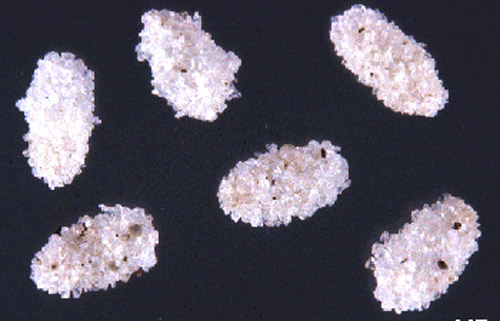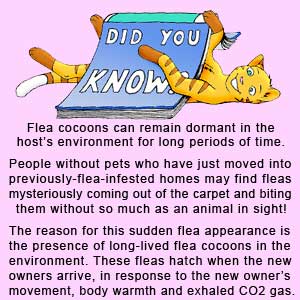Length of Life cycle:
Average 3-5 weeks but it is not uncommon to take 12 months
Note: This stage of the flea life cycle can lay dormant for 7-10 years
The pupae stage of the flea life cycle accounts for about 10 percent of the flea population in a home.
This cocoon stage is the last developmental stage before the adult flea emerges. The cocoon protects the pupae for several days or weeks before the adult flea emerges. If environmental conditions are not right for emergence, the cocoon can protect the developing flea for up to 12 months, and in some cases, years. A reproductive strategy that enhances the flea's chance of survival. This helps to explain how a flea infestation can seemingly “explode” out of nowhere, even inside your home
Cocoons have a sticky outer coating that allows them to hide deep in the carpeting and not be easily removed by light vacuuming or sweeping. The cocoon also serves to protect the developing adults from chemicals.
The adult flea will not emerge until the presence of a potential host is made obvious - by vibrations, rising levels of carbon dioxide, and body heat. This may be triggered by your pet walking by, or people moving in the house, alerting the flea to emerge from its cocoon to feed.
Average 3-5 weeks but it is not uncommon to take 12 months
Note: This stage of the flea life cycle can lay dormant for 7-10 years
The pupae stage of the flea life cycle accounts for about 10 percent of the flea population in a home.
This cocoon stage is the last developmental stage before the adult flea emerges. The cocoon protects the pupae for several days or weeks before the adult flea emerges. If environmental conditions are not right for emergence, the cocoon can protect the developing flea for up to 12 months, and in some cases, years. A reproductive strategy that enhances the flea's chance of survival. This helps to explain how a flea infestation can seemingly “explode” out of nowhere, even inside your home
Cocoons have a sticky outer coating that allows them to hide deep in the carpeting and not be easily removed by light vacuuming or sweeping. The cocoon also serves to protect the developing adults from chemicals.
The adult flea will not emerge until the presence of a potential host is made obvious - by vibrations, rising levels of carbon dioxide, and body heat. This may be triggered by your pet walking by, or people moving in the house, alerting the flea to emerge from its cocoon to feed.





